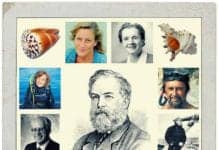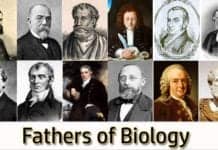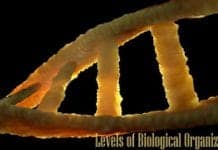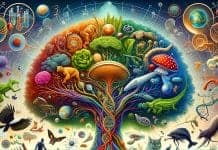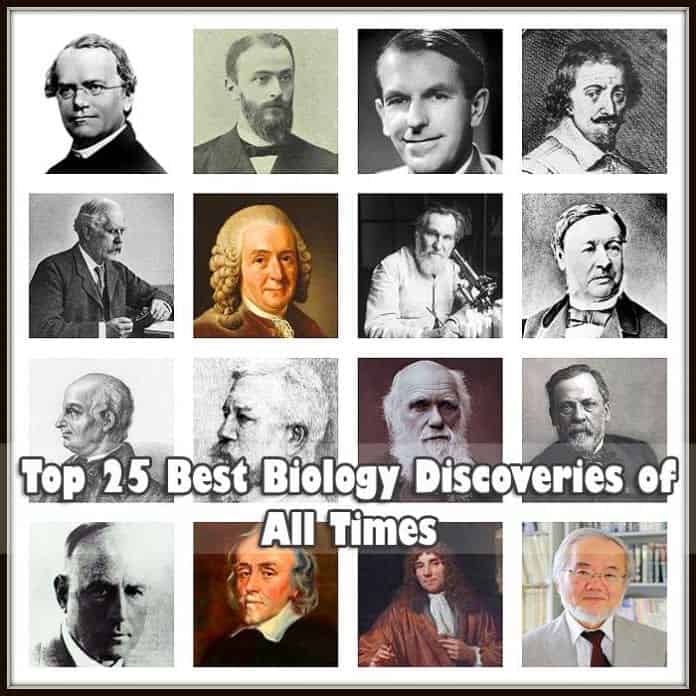
Top Biology Discoveries: Biology is an incredibly diverse science. It studies life from the most microscopic beings such as viruses and bacteria to the megafauna of deep history. Specialists in molecular biology can create a new life from scratch and edit existing genomes.
However, to get to this point, several important inventions and discoveries had been made, and several important theories formulated.
Table of Contents
- Top 25 Biology Discoveries
- First compound microscope.
- Blood circulation in animals.
- The first description of cells.
- Discovery of Microorganisms.
- Classification of life.
- Bacteria are not a product of a spontaneous generation.
- Cell theory.
- Germ theory.
- Theory of Evolution.
- The laws of heredity.
- Phagocytosis.
- Chromosomes and their role in fertilization.
- Tobacco mosaic virus.
- Inheritance of alkaptonuria.
- Bacterial transformation.
- Antibiotic penicillin.
- DNA methylation.
- Protein structure.
- Mobile genetic elements.
- DNA structure.
- DNA sequencing method by Frederick Sanger.
- The new kingdom of life.
- p53 protein.
- Genes controlling autophagy.
- Cas9/CRISPR system in bacteria.
Top 25 Biology Discoveries
Here are the top 25 biology discoveries of all time.
First compound microscope.
| Hans and Zacharias Janssen | 1590 | First compound microscope |
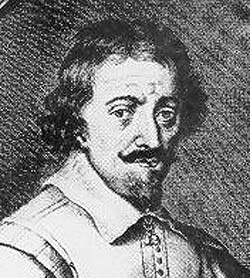 The father and son team from German town Middleburg have placed two spectacle lenses into a tube, one above the other and found out that such an instrument helps see microscopic objects.
The father and son team from German town Middleburg have placed two spectacle lenses into a tube, one above the other and found out that such an instrument helps see microscopic objects.
- Some of their microscopes even had three lenses and considerable magnification, even if the images were unclear.
- Their invention significantly impacted the development of science. Without the microscope, it would have been impossible to study cells, small animals, or bacteria.
![]()
Blood circulation in animals.
| William Harvey | 1628 | The first description of blood circulation in animals |
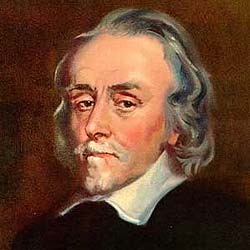 William Harvey was a British doctor. He has performed multiple dissections on dogs.
William Harvey was a British doctor. He has performed multiple dissections on dogs.
- He also had demonstrated his experiments before the other surgeons. Harvey has shown that the blood circulates in two loops: pulmonary and systemic.
- He has also discovered valves in veins and determined that blood can only move in specific directions in the body.
- He has published his findings in a book called “Anatomical Study of the Motion of the Heart and of the Blood in Animals“.
- Understanding how our blood vessels work was crucial for medicine and physiology. It has impacted treatments of the time and raised the interest in anatomy.
![]()
The first description of cells.
| Robert Hooke | 1665 | The first description of cells published. |
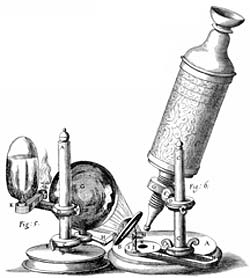 Robert Hooke was an accomplished inventor and scientist, a member of the Royal Society of London.
Robert Hooke was an accomplished inventor and scientist, a member of the Royal Society of London.
- He has improved the microscope made by Janssens and was the first person in history to describe cells in plant tissue.
- He has also depicted many other vital structures of plants, insects, and other animals.
- Hooke’s discoveries have started a trend in using microscopes for life studies, which have eventually led to multiple crucial discoveries.
- He has also become an example of proper scientific inquiry and high-quality scientific drawing.
- It would not have been possible to formulate the cell theory without Hooke’s discovery either.
![]()
Discovery of Microorganisms.
| Antonie van Leeuwenhoek | 1676 | Discovery of microorganisms. |
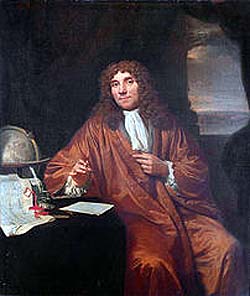 Leeuwenhoek has built his own small microscope and with its help has studied life histories of insects and microscopic organisms, such as protozoa and bacteria.
Leeuwenhoek has built his own small microscope and with its help has studied life histories of insects and microscopic organisms, such as protozoa and bacteria.
- He was also the first to show that microscopic organisms, which he has called animalcules, were present in water, on various surfaces, as well as foodstuffs.
- His discoveries were the start of microbiology and entomology. Without his work, people would not know that microorganisms cause illnesses and contamination.
![]()
Classification of life.
| Karl Linnaeus | 1758 | A first universal classification system of living beings was proposed. |
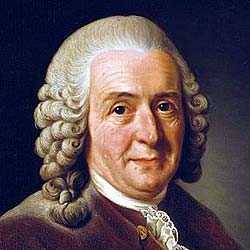 Karl Linnaeus, a Swedish scientist, has proposed a universal system of classification of living beings.
Karl Linnaeus, a Swedish scientist, has proposed a universal system of classification of living beings.
- The new system was hierarchical, Latin-based, and allowed easy communication between scientists.
- Each species was given a unique binomial name and belonged to a particular genus, family, order, class, and kingdom.
- Linnaeus system has been modified several times since then, but the initial idea still remains the same.
- The existence of the classification system has made the study of life significantly easier and also allowed to study evolutionary relationships between organisms in later centuries.
![]()
Bacteria are not a product of a spontaneous generation.
| Lazzaro Spallanzani | 1768 | The spontaneous generation theory is disproved. |
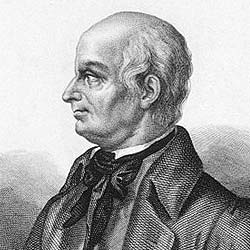 The experiment carried out by an Italian abbot and professor, Lazarro Spallanzani, has proven that microbes are not created through non-living “life force”, but can only come from other microorganisms.
The experiment carried out by an Italian abbot and professor, Lazarro Spallanzani, has proven that microbes are not created through non-living “life force”, but can only come from other microorganisms.
- This experiment has helped people admit that all animals, without exception descend from other animals of the same type, overthrowing the previously popular “spontaneous generation” theory.
- Spallanzani’s experiment has contributed to our understanding of the role of microorganisms and where they come from.
- It was also the basis for the pasteurization method, later developed by Pasteur.
![]()
Cell theory.
| Theodor Schwann, Matthias Schleiden, Rudolf Virchow | 1838 and 1858 | The establishment of cell theory. |
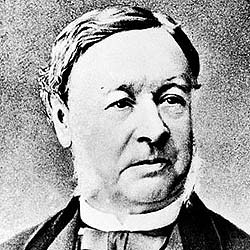 Theodor Schleiden, an animal specialist, and Matthias Schleiden, a botanist has come to the common conclusion: all living beings consist of units with similar shape and structure – cells.
Theodor Schleiden, an animal specialist, and Matthias Schleiden, a botanist has come to the common conclusion: all living beings consist of units with similar shape and structure – cells.
They have formulated the cell theory:
- All living beings are made of cells.
- Each cell is a functional unit and a building block.
Later in 1858, an outstanding German anatomist postulated a third important rule to the cell theory: all cells descend from other cells. The formulation of the cell theory was the start of cell biology as we know it. Without it, we would not understand many processes and certainly would not be able to fight such diseases as cancer.
![]()
Germ theory.
| Louis Pasteur | 1861-1862 | Microbes were proven to be responsible for illnesses. |
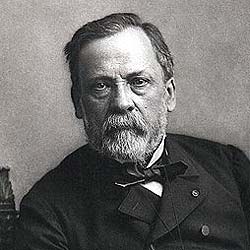 Louis Pasteur, a French microbiologist, and chemist is considered the father of modern microbiology.
Louis Pasteur, a French microbiologist, and chemist is considered the father of modern microbiology.
- His work was extremely extensive. His most notable achievements are proving beyond doubt that bacteria caused illnesses and the invention of pasteurization based on earlier Spallanzani’s experiment.
- We rely on pasteurization up to this day to preserve our food. Without vaccines and culture methods developed by Pasteur, we would not have been able to fight diseases of cattle and humans.
![]()
Theory of Evolution.
| Charles Darwin And Alfred Wallace | 1859 | Evolution theory. |
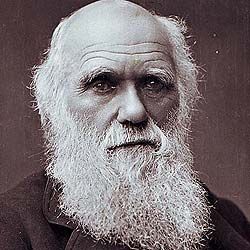 The British scientists Charles Darwin and Alfred Wallace has independently formulated a theory that explained the origins of life on Earth and mechanisms of evolution of species.
The British scientists Charles Darwin and Alfred Wallace has independently formulated a theory that explained the origins of life on Earth and mechanisms of evolution of species.
- Evolutionary theory has expanded dramatically since Darwin’s time, but the existence of natural selection is virtually undisputed up to this day.
- Darwin’s work has contributed significantly to our understanding of life on Earth and the processes that are still taking place today.
![]()
The laws of heredity.
| Gregor Mendel | 1866 | Discovery of the mechanisms of heredity. |
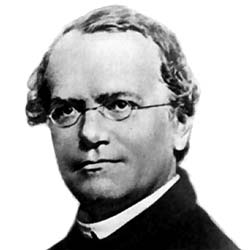 Gregor Mendel, an Austrian monk, and a mathematician have postulated the mechanisms of transferring inherited traits from parents to offspring.
Gregor Mendel, an Austrian monk, and a mathematician have postulated the mechanisms of transferring inherited traits from parents to offspring.
- He has used pea plants for his experiments and has discovered the existence of dominant and recessive alleles.
- Mendelian genetics is only one aspect of the complex mechanism of inheritance. However, it still plays a massive role in breeding programs in agriculture and understanding human disorders.
- Mendel also introduced statistics as a method of evaluating results and drawing conclusions, which is now widely used in all sciences.
![]()
Phagocytosis.
| lya (Elie) Ilyich Mechnikov | 1883 | Discovery of phagocytosis. |
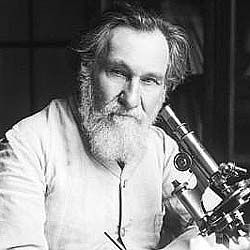 Ilya (Elie) Mechnikov has discovered the existence of specialized cells in animals (both vertebrate and invertebrate) that were responsible for eliminating pathogens and dead cells.
Ilya (Elie) Mechnikov has discovered the existence of specialized cells in animals (both vertebrate and invertebrate) that were responsible for eliminating pathogens and dead cells.
- ‘Mechnikov’s discovery has started immunology – the science devoted to the study of defense mechanisms against pathogens inside the body.
- Immunology helps significantly in our fight against pathogens and vaccine development.
![]()
Chromosomes and their role in fertilization.
| Edouard van Beneden | 1883 | Discovery of chromosomes. |
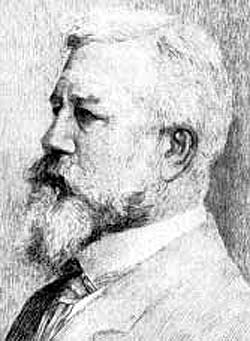 Edouard van Beneden, a Belgian embryologist and cytologist, has published several papers since 1883, describing chromosomes in the Ascaria worms eggs, as well the processes of fertilization and mitosis.
Edouard van Beneden, a Belgian embryologist and cytologist, has published several papers since 1883, describing chromosomes in the Ascaria worms eggs, as well the processes of fertilization and mitosis.
Without his discoveries, the next breakthroughs in understanding heredity in general and chromosome disorders, in particular, would have been impossible.
![]()
Tobacco mosaic virus.
| Dmitriy Ivanovsky | 1892 | The first description of tobacco mosaic virus. |
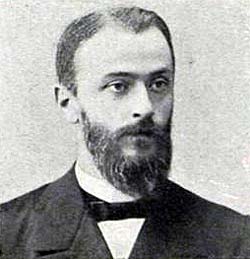 The Russian scientist Dmitriy Ivanovsky was studying tobacco plants that were affected by the illness called tobacco mosaic.
The Russian scientist Dmitriy Ivanovsky was studying tobacco plants that were affected by the illness called tobacco mosaic.
- He has proven that the illness was caused by an agent far smaller than regular bacteria.
- The actual term, “virus“, was coined later by Martinus Beijerinck in 1898.
- Due to the elegant experiment carried out by Ivanovsky, the scientific community has learned about viruses even though they could not really see them until the invention of the electron microscope.
![]()
Inheritance of alkaptonuria.
| Archibald Garrod | 1902 | Inheritance of alkaptonuria established. |
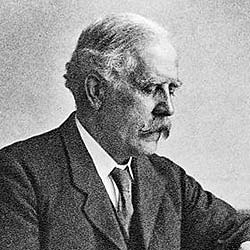 Archibald Garrod has studied family charts of patients with a metabolic disorder – alkaptonuria and has figured out that this illness is inherited according to Mendelian laws.
Archibald Garrod has studied family charts of patients with a metabolic disorder – alkaptonuria and has figured out that this illness is inherited according to Mendelian laws.
- It was the first description of an inheritable disease and the additional proof of the universality of Mendelian laws.
- Due to Garrod’s discovery, specialists could better understand the causes of diseases, such as hemophilia.
![]()
Bacterial transformation.
| Frederick Griffith | 1928 | Discovery of bacterial transformation. |
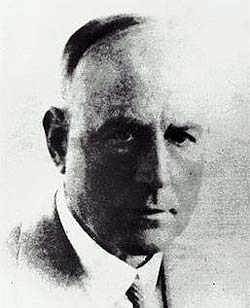 While experimenting with two bacterial strains of Staphylococcus pneumonia, Griffith has discovered that the traits from the dead bacteria can be transferred into living ones.
While experimenting with two bacterial strains of Staphylococcus pneumonia, Griffith has discovered that the traits from the dead bacteria can be transferred into living ones.
- This process was called transformation. Griffith’s discovery helped establish the role of DNA in heredity.
- The discovery of transformation and bacterial plasmids has also influenced the development of genetic engineering.
- Due to our knowledge of bacterial transformation, we can also understand how antibiotic resistance is spread in bacterial populations.
![]()
Antibiotic penicillin.
| Alexander Fleming | 1928 | Discovery of penicillin. |
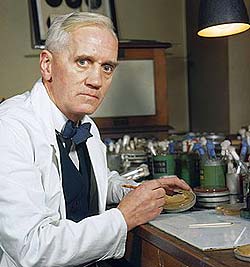 Alexander Fleming was working at St. Mary’s hospital in London, Great Britain.
Alexander Fleming was working at St. Mary’s hospital in London, Great Britain.
- He has accidentally discovered that the presence of certain types of molds in Petri dishes of bacterial cultures kills the bacteria.
- He has also purified the substance responsible for this effect. Though penicillin was discovered in 1928, its production as a drug had not started until the 1940s, when proper antibacterial care was crucial for wounded soldiers.
- The discovery of penicillin was the start of the antibiotic era, decreasing mortality from illnesses worldwide.
![]()
DNA methylation.
| Rollin Hotchkiss | 1948 | Discovery of DNA methylation. |
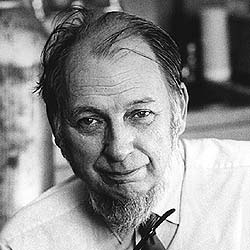 When Hotchkiss was studying a preparation of calf thymus, he has discovered that one of the DNA Nucleotides, cytosine, had an additional methyl group – was methylated.
When Hotchkiss was studying a preparation of calf thymus, he has discovered that one of the DNA Nucleotides, cytosine, had an additional methyl group – was methylated.
- Later, it was found that other nucleotides could be methylated, too.
- DNA methylation is one of the most common mechanisms of regulation of gene activity.
- We now know that this type of regulation called epigenetic regulation is crucial for our development and well-being.
![]()
Protein structure.
| Linus Pauling | 1950 | Protein structure discovered. |
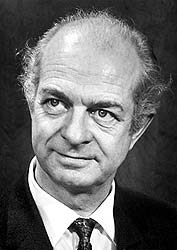 Using the data obtained from X-Ray crystallography and paper models, Linus Pauling has discerned how amino acids fit together to form proteins.
Using the data obtained from X-Ray crystallography and paper models, Linus Pauling has discerned how amino acids fit together to form proteins.
- He described the first structure as the protein alpha helix. Proteins play major roles in the functioning of cells and complex organisms, and determining their formation was the first step to understanding their activity.
- Pauling’s method has also influenced Watson and Crick and helped establish the DNA structure.
- Pauling’s discovery is now considered the start of molecular biology. Pauling was awarded a Nobel Prize in chemistry in 1954.
![]()
Mobile genetic elements.
| Barbara McClintock | 1950 | Discovery of mobile genetic elements. |
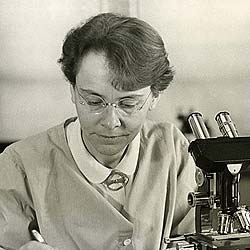 An American scientist, Barbara McClintock, was studying plants. Her particular area of interest was the mechanism of breaks in the chromosomes of the maize plants.
An American scientist, Barbara McClintock, was studying plants. Her particular area of interest was the mechanism of breaks in the chromosomes of the maize plants.
- She has discovered that there are areas in the chromosomes that can break away and re-insert themselves in other regions.
- This was one of the most astonishing discoveries of the 20th century, upending the scientist’s understanding of how the genome works and how mutations are generated.
- In later decades, it was found that mobile genetic elements (transposons) can be present in all living organisms, from viruses to mammals.
![]()
DNA structure.
| James Watson and Francis Crick | 1953 | Discovery of the DNA structure. |
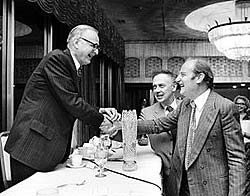 Based on data on the ratio of nucleotides and X-ray images made by another scientist, Rosalind Franklin, Watson and Crick have figured the DNA structure.
Based on data on the ratio of nucleotides and X-ray images made by another scientist, Rosalind Franklin, Watson and Crick have figured the DNA structure.
- They have shown that DNA is a double spiral with hydrogen bonds between complementary purine and pyrimidine bases.
- The discovery of DNA structure helped determine the mechanisms of replication, translation, and the DNA code itself.
![]()
DNA sequencing method by Frederick Sanger.
| Frederick Sanger | 1977 | Sanger sequencing method. |
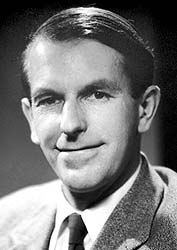 Frederick Sanger has developed a method that allows determination of the exact sequence of nucleotides in the genome using DNA polymerase, pre-made primers, and radioactive nucleotides.
Frederick Sanger has developed a method that allows determination of the exact sequence of nucleotides in the genome using DNA polymerase, pre-made primers, and radioactive nucleotides.
His method was significantly more straightforward and quicker than previous ones and helped substantially speed up DNA sequencing in bacteria, viruses, and later humans.
![]()
The new kingdom of life.
| Carl Woese | 1977 | The new kingdom of life discovered. |
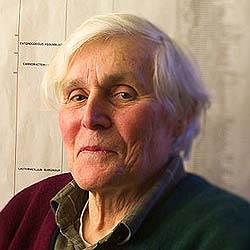 Carl Woese was sequencing a specific type of nucleic acid – ribonucleic RNA.
Carl Woese was sequencing a specific type of nucleic acid – ribonucleic RNA.
- He has discovered unicellular organisms without a nucleus with a completely different type of ribosomal RNA than bacteria and eukaryotes.
- He has shown that those organisms belonged to a completely separate kingdom of life. They were called archaea.
- modern scientific thought leans towards the idea that eukaryotes actually descended from Archaea through endosymbiosis.
![]()
p53 protein.
| Kress et al. | 1979 | P53 protein discovered. |
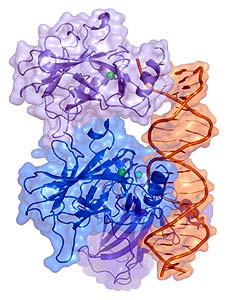 While studying how SV40 virus causes the development of the cancer tumors, Kress and his colleagues discovered a novel protein that was actively produced in the nuclei of cancer cells and was also associated with one of the viral antigens.
While studying how SV40 virus causes the development of the cancer tumors, Kress and his colleagues discovered a novel protein that was actively produced in the nuclei of cancer cells and was also associated with one of the viral antigens.
- Later research has uncovered that this protein was crucial in two critical processes: cancer development and programmed cell death – apoptosis.
- Among other things, p53 was then found to be involved in the cancerogenic effects of smoking.
![]()
Genes controlling autophagy.
| Yoshinori Ohsumi | 1992 | Discovery of autophagy genes. |
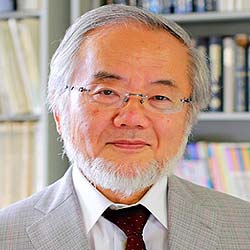 Autophagy is a process of self-destruction and recycling in the cell in response to stress.
Autophagy is a process of self-destruction and recycling in the cell in response to stress.
- Ohsumi has developed a method to study this process in yeast and has managed to find several genes responsible for this process.
- His work has contributed both to science and medicine, as autophagy was found to play a significant role in neurodegenerative diseases such as Alzheimer’s and Parkinson’s. Ohsumi was awarded a Nobel Prize in 2016 for his work.
![]()
Cas9/CRISPR system in bacteria.
| R. Barrangou et al. | 2007 | Discovery of Cas9/CRISPR system in bacteria. |
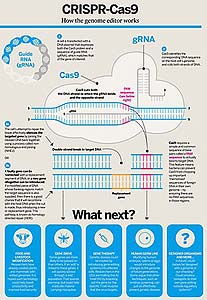 The team of scientists led by R. Barrangou has discovered that bacteria use special enzymes to cut out pieces of infecting virus that are lately inserted into the bacterial genome.
The team of scientists led by R. Barrangou has discovered that bacteria use special enzymes to cut out pieces of infecting virus that are lately inserted into the bacterial genome.
- This system helps bacteria recognize viruses in time. Later, the scientists realized that those bacterial enzymes can be used for editing the genomes of other organisms.
- This discovery was crucial for cancer research and other fields. First, gene editing in humans was also performed using this technique.
![]()
The history of biology is full of small and big discoveries that have greatly influenced our lives. These discoveries helped us understand life better and make incredible improvements in medicine.
This biology discoveries list only describes a few that have impacted the development of biology the most.
![]()


